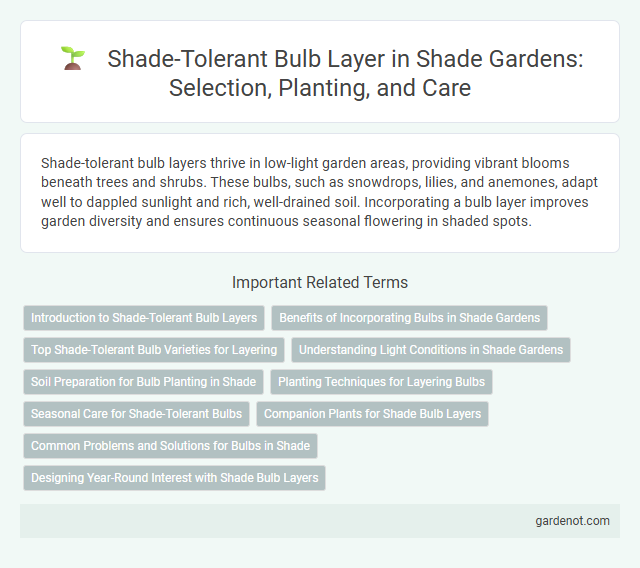Shade-tolerant bulb layers thrive in low-light garden areas, providing vibrant blooms beneath trees and shrubs. These bulbs, such as snowdrops, lilies, and anemones, adapt well to dappled sunlight and rich, well-drained soil. Incorporating a bulb layer improves garden diversity and ensures continuous seasonal flowering in shaded spots.
Introduction to Shade-Tolerant Bulb Layers
Shade-tolerant bulb layers consist of bulbs that thrive in low-light environments, making them ideal for shaded garden areas beneath trees or structures. These bulbs include species such as snowdrops, glory-of-the-snow, and cyclamen, which flourish in dappled or filtered sunlight. By incorporating shade-tolerant bulbs, gardeners can achieve vibrant spring blooms and enhanced seasonal interest in otherwise challenging shaded spaces.
Benefits of Incorporating Bulbs in Shade Gardens
Shade-tolerant bulb layers enhance shade gardens by providing seasonal bursts of color and texture that brighten dimly lit areas. These bulbs improve soil health through natural aeration and nutrient cycling, fostering a robust understory ecosystem. Incorporating shade-loving bulbs supports pollinators while increasing biodiversity and visual interest throughout varying growth stages.
Top Shade-Tolerant Bulb Varieties for Layering
Top shade-tolerant bulb varieties for layering include species like snowdrops (Galanthus), which bloom early in low-light conditions, and woodland hyacinths (Hyacinthoides non-scripta), prized for their vibrant blue flowers. Other excellent choices are the elegant trout lilies (Erythronium), known for their mottled leaves and delicate blossoms, and the resilient yellow aconites (Eranthis hyemalis) that add bright color to shaded garden beds. Layering these bulbs in staggered heights and bloom times ensures continuous seasonal interest in shade gardens with minimal sunlight.
Understanding Light Conditions in Shade Gardens
Shade-tolerant bulb layers thrive in low-light environments typically found under dense tree canopies or north-facing garden beds, where sunlight is diffused or intermittent. Selecting bulbs like snowdrops, bluebells, and lily of the valley ensures healthy growth as these species are adapted to absorb minimal light for photosynthesis. Understanding light intensity and duration in shade gardens helps optimize bulb placement, improving bloom density and longevity in shaded landscapes.
Soil Preparation for Bulb Planting in Shade
Soil preparation for shade-tolerant bulb planting requires well-drained, rich organic matter to support bulb growth despite limited sunlight. Incorporating compost and leaf mold enhances moisture retention and nutrient availability, essential for bulbs like snowdrops and colchicums. Ensuring loose, loamy soil with a pH of 6.0 to 7.0 promotes robust root development in shaded garden environments.
Planting Techniques for Layering Bulbs
Planting techniques for layering shade-tolerant bulbs involve selecting species with staggered bloom times to ensure continuous color throughout the growing season. Bulbs such as snowdrops, bluebells, and fritillaries thrive under tree canopies when planted in well-drained, organic-rich soil at varying depths to optimize root development and nutrient access. Strategic spacing and timing of bulb placement enhance airflow and reduce disease risk while maximizing seasonal interest in shade garden beds.
Seasonal Care for Shade-Tolerant Bulbs
Shade-tolerant bulbs such as snowdrops, bluebells, and cyclamen thrive with seasonal care that includes proper mulching to retain moisture and protection from harsh winter freezes. In early spring, removing old foliage and providing balanced fertilizer encourages healthy growth and vigorous blooms. Regular monitoring for pests and ensuring well-drained soil conditions prevent bulb rot and support sustained flowering throughout the growing season.
Companion Plants for Shade Bulb Layers
Shade-tolerant bulb layers thrive when paired with companion plants that also prefer low-light environments, such as ferns, hostas, and astilbes. These companion plants enhance soil moisture retention and provide a rich, organic mulch layer, promoting healthier bulb growth and prolonged blooms. Integrating shade-loving groundcovers like ajuga and lamium also minimizes weed competition and improves overall garden aesthetics.
Common Problems and Solutions for Bulbs in Shade
Shade-tolerant bulbs often face common problems such as poor flowering, rot from excessive moisture, and competition for nutrients due to limited sunlight in shaded garden areas. Solutions include planting bulbs with excellent shade adaptation like snowdrops, and ensuring well-draining soil with organic matter to prevent waterlogging. Regularly spacing bulbs to reduce competition and applying balanced fertilizers enhances growth and bloom quality in shade garden environments.
Designing Year-Round Interest with Shade Bulb Layers
Shade-tolerant bulb layers create dynamic year-round interest by combining early spring bloomers like snowdrops and bluebells with summer-flowering foliage such as caladiums and autumn bulbs like colchicum. Strategic layering of these bulbs ensures continuous color and texture, enhancing the garden's visual depth even under dense canopy cover. Selecting species adapted to low light conditions promotes healthy growth and sustained seasonal appeal in shaded garden areas.
Shade-tolerant bulb layer Infographic

 gardenot.com
gardenot.com